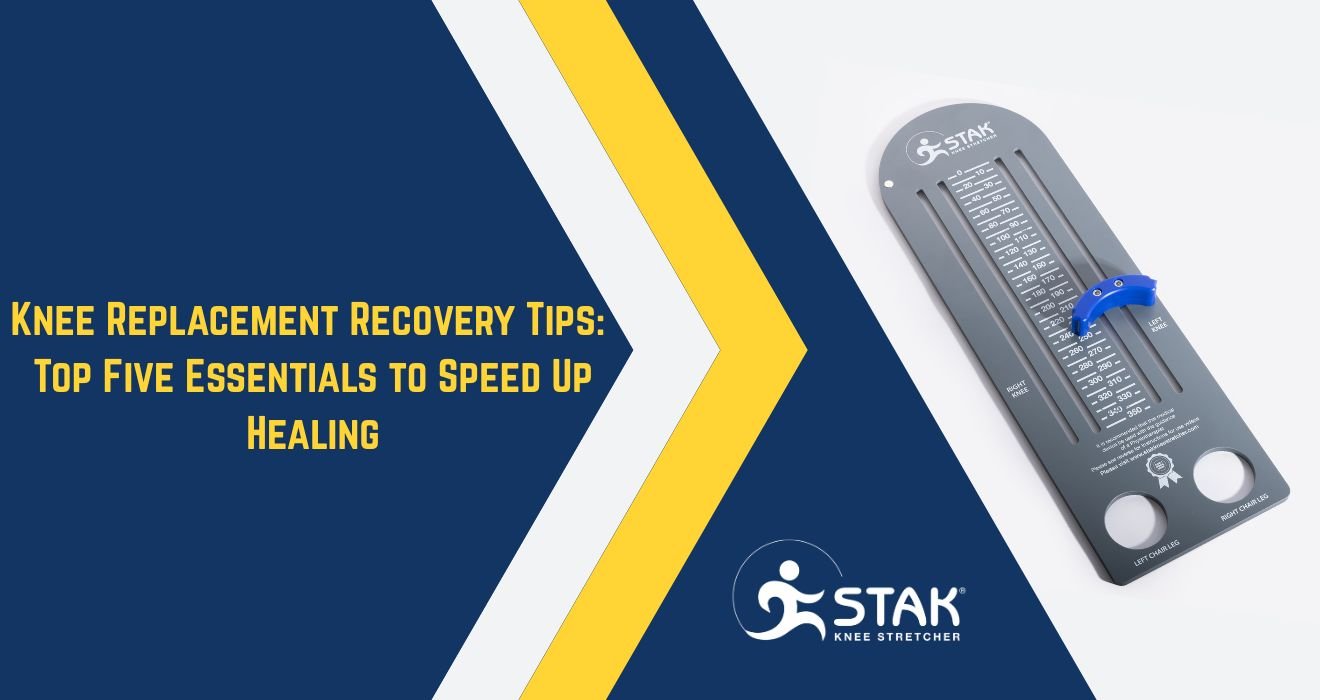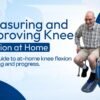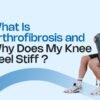Knee Replacement Recovery Tips: Top Five Essentials to Speed Up Healing
Knee Replacement Recovery Tips can make a big difference because recovering from a total knee replacement can be challenging, but taking the right steps can significantly speed up your recovery and help you regain mobility. Every patient’s journey is unique, but research and clinical experience highlight five essential strategies that can make a real difference
With the right guidance, tools, and dedication, you can optimise your recovery, reduce pain and stiffness, and return to daily activities more confidently. Here are the top five essentials for a faster, smoother recovery following knee replacement surgery.
1. Physiotherapy and Exercise
Structured physiotherapy and exercise are crucial in restoring knee function after surgery. Engaging in a tailored programme helps improve strength, flexibility, and range of motion, which are essential for walking, bending, and overall mobility.
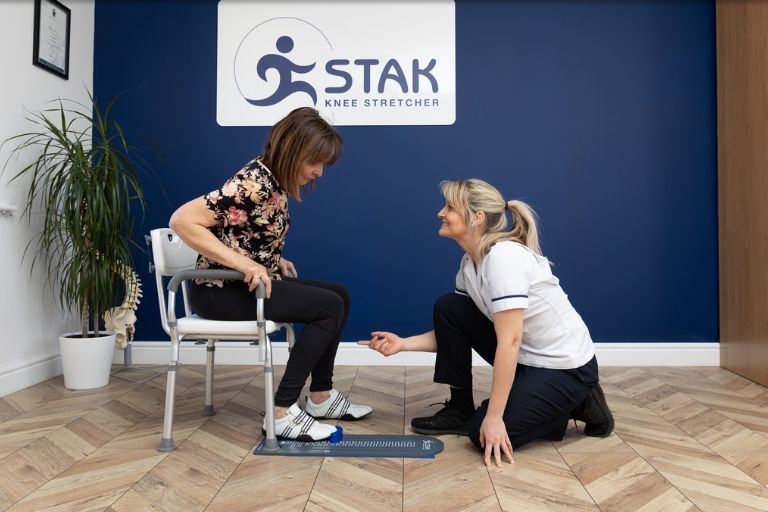
Why It Matters
After knee replacement, muscles around the joint may be weak, and scar tissue can limit movement. Regular physiotherapy ensures the joint moves safely, prevents stiffness, and promotes long-term function. Evidence shows that patients who commit to daily exercise routines recover faster and maintain better joint health over time.
How STAK Helps
The STAK programme offers a structured physiotherapy plan designed specifically for knee replacement patients. It includes exercises that target key muscle groups and enhance joint mobility. By combining these exercises with the STAK tool, patients can perform high-intensity stretches safely at home, accelerating recovery beyond what standard exercises achieve.
📘 Download Your Free Arthrofibrosis Tips Guide
Take your first step today. Download our free resource to help you structure your recovery at home.
⬇ Download Now2. Pain Management
Managing pain effectively is vital to ensure you can participate fully in physiotherapy and daily exercises. Pain can hinder movement, reduce motivation, and slow the healing process if not properly addressed.
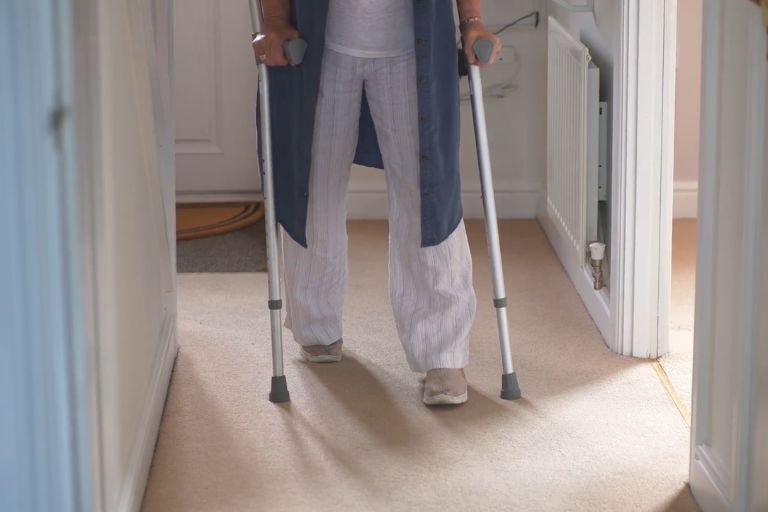
Tips for Effective Pain Control
- Follow your prescription: Take pain medications as directed by your healthcare provider.
- Stay ahead of discomfort: Don’t wait for pain to become severe before taking medication or applying supportive measures.
- Use ice and elevation: These can reduce swelling and improve comfort.
STAK Support
The STAK programme provides guidance on safe pain management and how to integrate it with your rehabilitation exercises. While STAK does not prescribe medications, it supports patients in following professional advice, helping you remain comfortable and active during recovery.
3. Rest, Ice, and Elevation
Proper rest and positioning play a significant role in recovery. Elevating your leg above heart level and using ice therapy reduces swelling, improves circulation, and helps control post-operative pain.
Best Practices
- Rest appropriately: Give your body time to heal, especially in the first few weeks after surgery.
- Elevate your leg: Use pillows to keep your knee raised while sitting or lying down.
- Apply ice packs: Use therapeutic ice packs or wraps to manage swelling and discomfort, ideally for 15–20 minutes at a time, several times per day.
STAK Assistance
STAK supplies ice packs and wraps designed for home use. Alongside the STAK programme, these tools support a comprehensive recovery plan, ensuring patients can combine rest, therapeutic icing, and stretching effectively.
4. Follow Post-Operative Instructions
Following your surgeon’s and physiotherapist’s instructions is critical for a smooth recovery. Ignoring guidance can lead to complications, delayed healing, or reduced joint function.
Key Considerations
- Wear recommended supports: Compression socks or braces may be advised to prevent swelling and support the joint.
- Attend follow-ups: Regular appointments allow your healthcare team to monitor progress and adjust your rehabilitation plan.
- Avoid prohibited activities: Some movements or exercises may be unsafe during early recovery; follow guidance carefully.
STAK Programme Integration
The STAK programme ensures that all exercises, tool usage, and rehabilitation steps align with your post-operative instructions. Patients follow a bespoke plan developed by specialist physiotherapists, helping them stay on track safely and confidently.
5. Hire the STAK Tool and Enrol in the STAK Programme
The STAK Knee Flexion Tool is a clinically proven, class 1 medical device designed to deliver high-intensity stretching safely at home. Research and patient outcomes show that using STAK significantly accelerates recovery compared to standard physiotherapy alone.
How STAK Works
- The tool allows intense, controlled stretching to break down scar tissue.
- Patients gain significant improvement in knee flexion; studies show an average 30° increase in range of motion in just 8 weeks, compared to only 8° with standard physiotherapy.
- Users remain in full control of the intensity, adjusting stretches using their own body weight and leverage.
Benefits
- Lightweight and reusable: Easy to store and handle at home.
- Time-efficient: Recommended use is three 20-minute sessions daily.
- Safe and motivating: Encourages active participation in your own recovery.
Comprehensive STAK Programme
The programme includes:
- Bespoke physiotherapy guidance
- Step-by-step usage of the STAK tool
- Ice packs for therapeutic use
- Support from specialist physiotherapists to monitor and adjust your recovery
By hiring the STAK tool and following the programme, patients can take full control of their recovery, regain mobility faster, and reduce pain and stiffness effectively.
Evidence of Effectiveness
Clinical data supports STAK’s role in post-operative recovery:
- Range of Motion Improvement: 30° increase in 8 weeks with STAK vs 8° with standard physiotherapy.
- Pain Reduction: High-intensity controlled stretches reduce stiffness and discomfort.
- Functional Gains: Patients report improved daily activity performance and confidence in movement.
These outcomes underline the advantage of structured, device-assisted rehabilitation at home, making STAK a proven choice for knee replacement recovery.
Conclusion
Recovery from knee replacement surgery can be challenging, but the right strategies make a substantial difference. The five essentials—structured physiotherapy, effective pain management, rest with ice and elevation, adherence to post-operative instructions, and the STAK tool & programme—together form a comprehensive, evidence-based approach to optimise recovery.
By integrating STAK into your rehabilitation, you benefit from a clinically supported, home-based solution that improves range of motion, reduces pain, and accelerates return to normal activities.
Take the next step in your recovery today. Hire the STAK Tool and join the bespoke STAK Programme to regain mobility, independence, and confidence after knee replacement.
Contact STAK Today:
- Phone: 07799521653
- Email: info@stakkneestretcher.com
- Website: STAK Knee Flexion Tool
